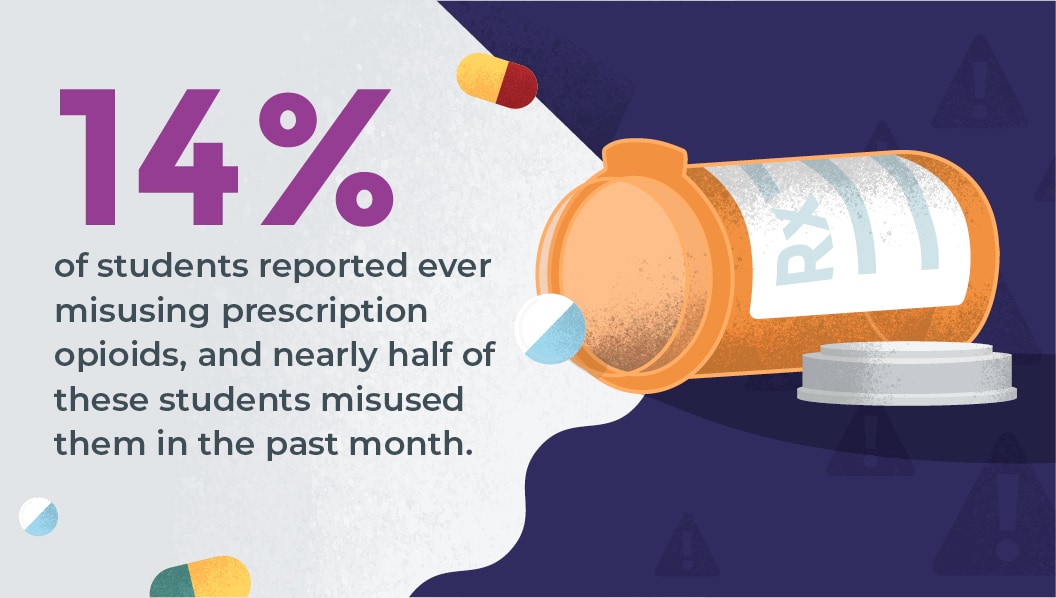Youth High-Risk Drug Use
High-risk drug use increases the likelihood that youth will engage in risk behaviors that can have dramatic, and lasting effects on their health and academic performance.
High-risk drug use refers to any use by adolescents of drugs with a high risk of adverse outcomes, such as injury, criminal justice involvement, school dropout, and loss of life. This includes:
- Misuse of prescription drugs
- Use of illegal drugs like cocaine, heroin, methamphetamines, inhalants, hallucinogens, or ecstasy
- Use of injection drugs, which have a high risk of transmitting HIV and hepatitis1
Youth who use high-risk drugs are more likely to also:
- Engage in risky sexual behaviors (not using a condom, multiple partners).
- Experience violence, such as physical and sexual dating violence, and being bullied, threatened, or injured.
- Be at greater risk for mental health problems and suicide.2-3

Youth opioid use is linked to risky behaviors like not using a condom and that can lead to HIV, STDs, and unintended pregnancy.
These health risk behaviors and experiences put youth at greater risk for sexually transmitted infections, like HIV and other STDs, and unintended pregnancy.4 Some of these behaviors, like drug use and having sex at an early age, are also consistently linked to poor grades, test scores, and lower educational attainment.5-9
Preventing High-Risk Drug Use
We can take steps to prevent adolescent drug use that will help them stay healthier for decades to come and perform better in school. A majority of adults with substance abuse disorders and addictions started during their adolescent and young adult years.10
Schools, parents, and families can help prevent high-risk drug use, both individually and by working together.

Schools
Schools can use strategies shown to prevent high-risk drug use and other risk behaviors:
- Create safe and supportive school environments that successfully connect students to a network of caring peers and adults in school and the surrounding community. Provide training for staff, programs focused on positive youth development, policies that support all youth, and activities, such as student-led clubs that support LGBTQ youth.
- Deliver quality health education and sexual health education that prepare students with the knowledge and skills needed to make informed health decisions.
- Connect students to mental and sexual health services at school or in the community.

Schools can also foster school connectedness and parent engagement in schools, two key factors that protect students from using high-risk drugs and from other health risk behaviors and experiences:
- Make students feel connected by showing them that adults and peers in their school care about them as individuals. Implement strategies and actions to strengthen school connectedness among your students.
- Find ways to work together with parents and families to support and improve the learning, development, and health of your students and their adolescents.
Safe and supportive environments can foster both school connectedness and parent engagement.
They also support youth mental health and well-being. Both are linked to better student behavior and academic performance.11
Parents and Families
Schools, families, and communities should work together to build a safe environment for youth at school and at home.
- Talking to youth about high-risk drug use and sexual risk behaviors tells them someone cares about them.
- Getting engaged in and involved at their schools can make a big difference in their lives and doesn’t have to take a lot of time.

Studies show that parental involvement in the lives of adolescents can reduce the chance that they will use high-risk, nonmedical prescription, and illegal drugs.12-13
Parents and families can:
- Communicate honestly and openly with adolescents about the risks of using drugs and engaging in sexual risk behaviors to help them make healthy decisions and protect their health now and in the future.
- Learn more about what is going on at school in ways that fit your schedule, communicate what you think would be helpful, and read information that comes home.
- Help adolescents feel more connected to school, which can protect them from engaging in risky behaviors like using high-risk drugs, by taking these concrete steps to promote connectedness among youth.
- Centers for Disease Control and Prevention, Division of Adolescent and School Health. (2019, April 18). High-Risk Substance Use Among Youth.
- Clayton HB, Lowry R, Basile KC, Demissie Z, Bohm MK. Physical and sexual dating violence and nonmedical use of prescription drugs. Pediatrics, 2017;140(6), e20172289.
- Clayton HB, Bohm MK, Lowry R, Ashley C, Ethier KA. Prescription opioid misuse associated with risk behaviors among adolescents. American Journal of Preventive Medicine, 2019;57(4), 533–539. https://doi.org/10.1016/j.amepre.2019.05.017.
- Clayton HB, Lowry R, Basile KC, Demissie Z, Bohm MK. Physical and sexual dating violence and nonmedical use of prescription drugs. Pediatrics, 2017;140(6), e20172289.
- Carlson SA, Fulton JE, Lee SM, Maynard M, Drown DR, Kohl III HW, Dietz WH. Physical education and academic achievement in elementary school: data from the Early Childhood Longitudinal Study. American Journal of Public Health2008;98(4):721–727.
- Spriggs AL, Halpern CT. Timing of sexual debut and initiation of postsecondary education by early adulthood. Perspectives on Sexual and Reproductive Health2008;40(3):152–161.
- Srabstein J, Piazza T. Public health, safety and educational risks associated with bullying behaviors in American adolescents. International Journal of Adolescent Medicine and Health2008;20(2):223–233.
- Rasberry CN, Tiu GF, Kann L, McManus T, Michael SL, Merlo CL, Lee SM, Bohm MK, Annor F, Ethier K. Health-related behaviors and academic achievement among high school students—United States, 2015. MMWR Morb Mortal Wkly Rep2917;66:922-927.
- Bradley BJ, Greene AC. Do health and education agencies in the United States share responsibility for academic achievement and health? A review of 25 years of evidence about the relationship of adolescents’ academic achievement and health behaviors. J Adoles Health2013;52:523-532.
- S. Department of Health and Human Services (HHS), Office of the Surgeon General, Facing Addiction in America: The Surgeon General’s Report on Alcohol, Drugs, and Health. Washington, DC: HHS, November 2016.
- Centers for Disease Control and Prevention, Division of Adolescent and School Health. (2019, November 21). Fostering School Connectedness: Improving Student Health and Academic Achievement.
- Nargiso JE, Ballard EL, Skeer MR. A systematic review of risk and protective factors associated with nonmedical use of prescription drugs among youth in the United States: A social ecological perspective. Journal of Studies on Alcohol and Drugs, 2015;76(1), 5–20.
- Nakawaki B, Crano W. Patterns of substance use, delinquency, and risk factors among adolescent inhalant users. Substance Use & Misuse, 2014;50(1), 114–122.